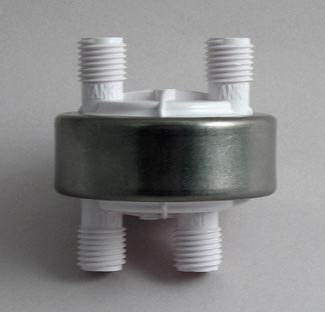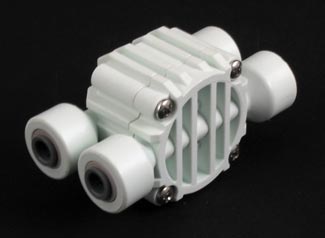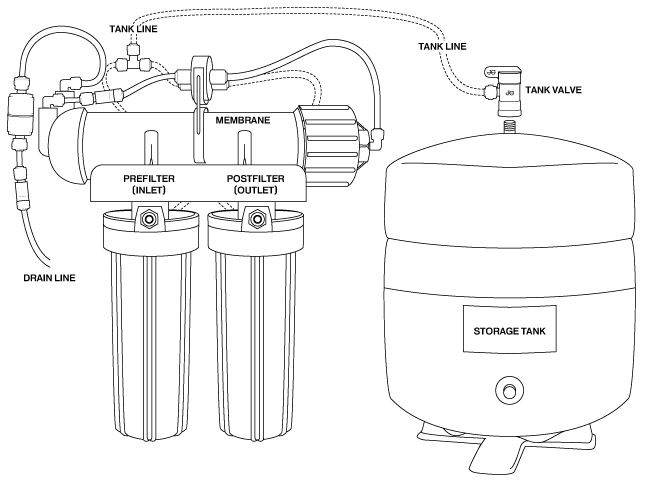How Reverse Osmosis Shutoff Valves Work

Modern undersink reverse osmosis units use a simple but effective shutoff device to turn off water production when the unit's storage tank is full. The shutoff system monitors the pressure in the storage tank and shuts off water coming into the RO membrane when tank pressure reaches approximately 2/3 of the pressure of the incoming tap water.
The Payne brand shutoff pictured above is installed as follows:
1. After water leaves the RO unit's prefilter, it enters the "In" port of the shutoff valve, lower right in the picture. It then makes a horseshoe turn and exits the "Out" port, lower left in the picture, through which it flows to the inlet side of the RO membrane.
2. When the "permeate" water (the product water of the RO unit) leaves the other end of the membrane housing, it flows to one of the "tank" ports on the other side of the shutoff valve. It doesn't matter which port it enters, since the "tank" ports are interchangeable and water flows either way on this side of the valve. Water then makes a horseshoe turn inside the top side of the valve and leaves through the other tank port. From there it flows to the storage tank.
3. The two halves of the valve are separated by a piston, which keeps the permeate water on one side and the incoming tap water on the other. As long as the pressure on the tank side is less than 2/3 the pressure on the tap water side, the piston remains open and the unit continues to produce water. As the RO produces water and slowly fills the storage tank, however, pressure on the tank side of the piston eventually becomes strong enough to force the piston toward the tap water side and shut off the incoming tap water, stopping production. The RO unit stays off until enough water is removed from the storage tank to drop the pressure on the tank side of the piston, allowing tap water pressure to push the piston toward the tank side and start RO production again.
 |
|---|
| The Flowmatic shutoff valve above works exactly like the Payne valve, although the flow pattern is straight through rather than horseshoe style. In other words, tap water enters the lower right and flows out the upper right toward the membrane, while the lower left and the upper left ports handle the permeate to tank water. |
It is important to know that in order for the shutoff system to work, a check valve (one-way valve) must me installed in the permeate tube between the membrane and the shutoff valve. Without the check valve to contain the back pressure from the tank, the shutoff valve cannot function.
 |
|---|
| The Payne shutoff valve is clipped to the membrane housing of the unit above. The tubes on the right side carry tap water to the membrane. On the left, or "tank" side, permeate water leaves the membrane, passes through the cigar-shaped check valve, and enters one of the shutoff valve's "tank" ports. It leaves via the other tank port and flows to the tee, which sends it to the storage tank. |
More about reverse osmosis shutoff valves and other reverse osmosis parts.